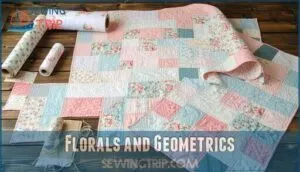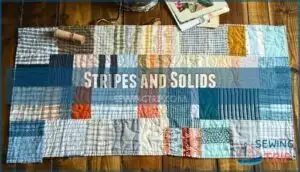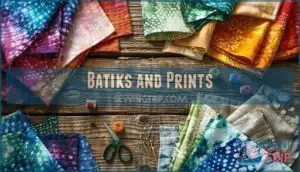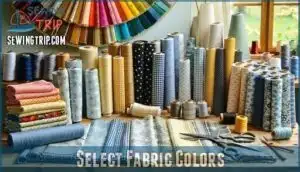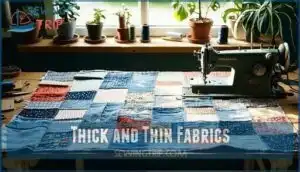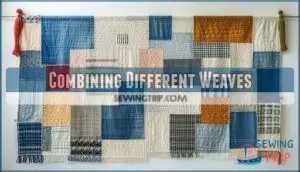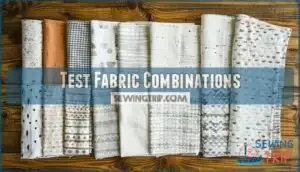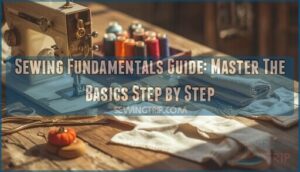This site is supported by our readers. We may earn a commission, at no cost to you, if you purchase through links.
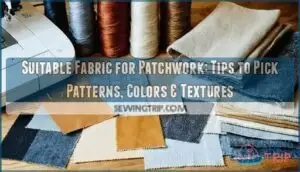
Cotton is your go-to: it’s breathable, durable, and easy to sew.
Linen adds texture, great for creating visual interest, though it frays more, so prep those edges.
For a bold statement, leather or faux leather can add modern flair but requires stronger needles and patience.
Mix patterns—like florals, stripes, or solids—and play with color schemes using the trusty color wheel.
Test combinations with small swatches first—it’s all about harmony.
Ready to level up your fabric pairing skills?
Table Of Contents
Key Takeaways
- Choose cotton for patchwork—it’s durable, breathable, and super easy to sew, making it the top pick for most projects.
- Mix patterns like florals, stripes, and solids, but make sure you stick to a harmonious color scheme using a color wheel.
- Add variety with textures like linen, but prewash and watch for fraying edges; consider leather for bold patches but use stronger needles.
- Test fabric combos with swatches to ensure colors, patterns, and textures work together before committing to your final design.
Choose Fabric Type
When picking fabrics for patchwork, you’ll want to choose materials that suit your project’s purpose and durability needs.
Cotton is a favorite because it’s easy to work with, but don’t overlook linen or even leather for bold, creative designs.
Cotton Fabrics
Cotton fabrics are a patchwork powerhouse—soft, durable, and easy to sew.
Cotton is the heart of patchwork—soft, durable, versatile, and your go-to fabric for seamless creativity.
Quilting cotton is ideal, offering medium weight and vibrant colors. Pre-washed cotton prevents shrinkage and guarantees long-lasting creations.
When selecting fabrics, consider the benefits of high quality cotton for your projects.
- Quilting cotton: Balanced weight, perfect for beginners.
- Cotton prints: Add flair with stunning designs.
- High thread count: Improves softness and durability.
- Weave types: Enhance texture and depth.
- Cotton blends: Avoid for consistent shrinkage and wear.
Linen Fabrics
Linen fabrics bring an earthy, natural touch to your patchwork.
Their breathable fabric is perfect for lighter projects but check the fabric weight—too heavy and stitching gets tricky.
Linen blends are also worth exploring as they balance durability with softness.
Look for a tight weave and high thread count to avoid fraying.
Linen complements patchwork cotton beautifully, adding texture and charm.
When selecting linen, consider the linen fabric quality to guarantee the best results for your project.
Leather Fabrics
Why consider leather for patchwork? Its durability and textured finish make it unique.
Leather can transform ordinary projects into standout pieces, but it requires careful handling.
- Opt for thinner leather types to match fabric weight.
- Use leather dyes to customize colors creatively.
- Finish edges with care to prevent fraying.
- Keep leather care in mind; it’s not as forgiving as breathable fabrics.
Consider Fabric Patterns
When choosing fabric patterns, think about how florals, stripes, or bold geometrics will work together in your project.
Mixing different scales and styles keeps your patchwork visually interesting without overwhelming the design.
Florals and Geometrics
Floral patterns and geometric designs are perfect for adding flair and balance to your patchwork quilting.
A floral mix can bring softness, while geometric patterns offer structure.
Focus on color harmony by blending complementary shades.
Play with print scale—pair large blooms with smaller geometrics for variety.
This thoughtful fabric selection guarantees your quilt feels cohesive, blending artistry and comfort in every stitch.
For inspiration, explore various floral quilt patterns to find the perfect fit for your project.
Stripes and Solids
Stripes and solids are the dynamic duo of patchwork quilts.
Striped fabrics add energy, while solid colors ground the design with balance.
Pattern mixing becomes easier when you pair a bold stripe with a soothing solid.
Use fabric contrast to your advantage—thin stripes pop against deep solids.
Textile blends, like cotton and linen, enhance variety.
Let these pairings fuel your quilting creativity.
Understanding fabric selection basics is essential for achieving a harmonious quilt design.
Batiks and Prints
Batiks bring an artistic flair to patchwork quilts with their vibrant, hand-dyed patterns, while fabric prints add personality and texture.
When mixing prints, balance bold statements with quieter designs for harmony.
Layering batik designs with other quilting fabrics creates dynamic Quilt Motifs. Explore Textile Blends for depth, and trust your instincts.
Fabric selection should feel like storytelling—unique, expressive, and completely yours.
Select Fabric Colors
Choosing the right colors for your patchwork can make or break your design, so start with a fabric you love and build from there.
Use tools like the color wheel or selvedge dots to create a balanced and visually appealing palette.
Color Wheel Combinations
The color wheel is your best friend when picking fabric colors for patchwork quilts.
Analogous hues, like blue, teal, and green, make soothing combinations. Want a pop? Try triadic colors—red, yellow, and blue—for balance.
For striking results, use split complements, such as purple with yellow and orange.
Warm neutrals or cool tones can ground your design and create perfect color coordination.
Monochromatic Schemes
Monochromatic schemes bring a timeless vibe to your patchwork quilt design.
Using a single hue with tonal variations or color gradations adds depth while keeping things cohesive.
Think neutral tones for subtlety or bold hues for impact.
It’s about mastering color coordination in your fabric selection process.
Mix light, medium, and dark shades to create movement and avoid a flat, lifeless look.
Complementary Colors
Pairing complementary colors is like finding a perfect dance partner—they contrast yet complement each other beautifully.
Use the color wheel to match opposites, like blue and orange, for vibrant color harmony.
Balance hues and saturation levels for eye-catching contrast theory.
Mix tint shades of bold patterns with subtle ones to add depth.
Complementary color schemes create quilts that pop with personality and warmth.
Mix Fabric Textures
Mixing fabric textures adds depth and interest to your patchwork, making the final piece visually and tactilely engaging.
Combine smooth cottons with textured linens or pair thick wools with lightweight fabrics to create a balanced and unique design.
Smooth and Rough Textures
When diving into patchwork, texture becomes your secret weapon for creating depth and intrigue.
Texture is the soul of patchwork, turning every quilt into a rich tapestry of touch and depth.
Smooth and rough textures transform ordinary quilts into tactile masterpieces that beg to be touched.
- Silk meets raw cotton for unexpected contrast
- Velvet patches nestled against crisp linen
- Soft flannel blending with textured wool
- Shimmering satin alongside nubby raw silk
Mastering fabric texture is like conducting a symphony of sensations, where each fabric tells its own rich story.
Thick and Thin Fabrics
Using both thick and thin fabrics in patchwork adds texture and intrigue, but be cautious of thickness variance. Thicker fabrics like denim need stronger stitches, while delicate fabrics might need stabilization.
Balance different fabric weights for durability and artistry. Remember, thread count affects drape and durability. Pre-wash pieces to avoid surprises later!
When working with thick fabrics, considering thick fabric properties is essential for a successful patchwork project.
| Fabric Type | Weight Range | Uses | Benefits | Challenges |
|---|---|---|---|---|
| Quilting Cotton | Light | Traditional patchwork | Easy to sew | May lack structure |
| Denim | Thick | Bags, jackets | Durable | Harder to stitch |
| Linen | Medium | Home décor | Breathable, versatile | Wrinkles easily |
| Fabric Blends | Varies | Diverse projects | Balanced characteristics | Require testing |
| Silk | Thin | Decorative accents | Luxurious, delicate | Needs careful handling |
Combining Different Weaves
Blending different weave types in patchwork brings dimension and character to your quilt.
Mixing yarn mixtures and fabric blends keeps texture combos engaging while maintaining pattern harmony.
Play around with thread counts for variety—like pairing smooth sateen with a nubby twill.
- Combine tight weaves with looser ones for depth.
- Balance lightweight quilting fabric with sturdier materials.
- Test swatches to guarantee seamless texture integration.
Understanding fabric weave basics is vital for achieving the desired texture and durability in patchwork quilts, and to ensure seamless texture integration.
Test Fabric Combinations
Testing fabric combinations helps you spot what works and what doesn’t before cutting into your stash.
Lay out potential picks side by side to see how colors, patterns, and textures play together—it’s like auditioning a cast for your quilt, which is a crucial step in understanding how different elements work together.
Creating Test Swatches
When experimenting with fabric types and textures, creating test swatches is your best friend.
Cut small squares of potential fabrics and lay them side by side.
This simple step helps with fabric sampling, color testing, and texture mixing.
Hold them in different lighting to visualize the overall effect.
It’s a hands-on way to enhance patchwork techniques and guarantee cohesive results.
To achieve professional-looking garments, understanding the importance of muslin testing process is vital for making adjustments and guaranteeing a perfect fit.
Auditioning Fabric Pairings
Fabric auditions are like casting the perfect actors for your quilt.
Lay fabrics side by side and check for color harmony, print mixing, and texture blending.
Test combinations under different lighting to verify balance.
Don’t shy away from bold fabric contrast; it adds personality.
Adjust selections until you achieve effortless fabric coordination and a quilt balance that makes you smile.
Seeking Outside Opinions
Talk to a friend or join a quilting group for fresh perspectives.
Social media and online forums are great for fabric suggestions and feedback.
Post combinations and ask for opinions—quilters love sharing advice.
Expert advice from shop assistants also helps.
Engaging the quilting community creates belonging, while fabric opinions from others might spark unexpected ideas.
Sometimes, another eye sees magic you’ve missed!
Frequently Asked Questions (FAQs)
What fabric to use for patchwork?
You’ll want cotton—it’s breathable, easy to sew, and holds shape beautifully.
For creativity, mix it with denim or linen for texture.
Play around with patterns; even unexpected choices like bright florals can add magic.
How to choose fabric for a patchwork quilt?
Start with a fabric that sparks joy—like finding a diamond in the rough.
Choose a favorite color or pattern as your anchor, then mix light, medium, and dark prints for depth and charm.
Can any fabric be used for quilting?
You can quilt with almost any fabric, but cotton’s your best friend for ease and durability.
Fancy trying denim or silk? Go for it!
Just match the fabric to your project’s needs and personality.
What makes a good quilting fabric?
The best quilting fabric is 100% cotton—it’s soft, durable, and easy to sew.
Its tight weave holds shapes well.
Choose fabrics with vibrant colors and patterns that inspire, creating warmth, love, and lasting memories.
How does fabric weight impact patchwork durability?
Over 70% of patchwork durability relies on fabric weight.
Heavier fabrics, like denim, withstand wear but can strain seams.
Lightweight cottons balance strength and finesse, keeping projects cozy yet lasting—like the perfect hug over time.
What are eco-friendly options for patchwork projects?
Choose organic cotton, sustainably sourced linen, or upcycled denim for patchwork.
These eco-friendly fabrics offer durability, charm, and environmental benefits.
Plus, there’s something heartwarming about giving old materials a fresh start in your handmade masterpiece!
Are certain fabrics easier for beginners to sew?
Cotton’s your go-to—it’s like the training wheels of sewing.
It’s sturdy, easy to handle, and forgiving when you make small mistakes.
Avoid slippery silks or stretchy fabrics—they’re trouble until you’ve got more practice.
How do seasonal themes influence fabric selection?
Ever noticed how seasons set the tone for everything?
Fabrics follow suit! Cozy flannels in winter or vibrant florals for spring make your creations feel timely.
Seasonal themes add warmth and connection to your project.
What washing methods preserve patchwork fabric quality?
Handle patchwork gently: wash in cold water with mild detergent and a delicate cycle.
Dry flat or tumble dry low to avoid shrinking or fading.
Avoid harsh detergents—your quilt deserves better than that, with mild detergent being the preferred choice.
Conclusion
Did you know cotton makes up about 73% of patchwork projects?
That’s because finding suitable fabric for patchwork is all about balance. Choose fabrics like cotton for ease, linen for texture, or leather for boldness, then mix patterns and colors to create harmony.
Experiment with textures and use a color wheel to guide combinations. Test swatches before committing to your final design.
With practice, you’ll confidently pair fabrics that bring your vision to life, and this will lead to happy stitching!
- https://www.patchwork-europe.eu/en/the-patchwork/what-kind-of-fabric-should-you-use-for-a-patchwork
- https://blog.fatquartershop.com/the-quilters-fabric-guide-how-to-choose-the-right-fabric-for-your-next-quilt
- https://www.craftsy.com/post/best-fabric-for-quilting
- https://www.quora.com/What-fabric-companies-make-the-best-quality-quilting-fabric-in-the-industry
- https://www.reddit.com/r/quilting/comments/ysxdca/fabric_types

